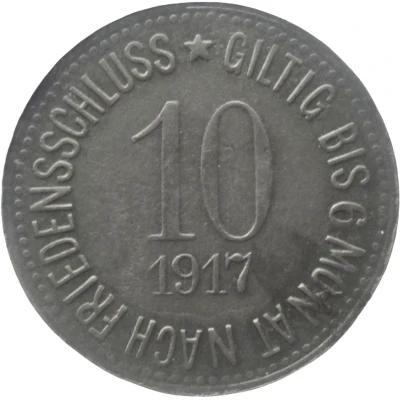


© Willem63 (CC BY-NC-SA)
10 Pfennigs - Kemnath
1917 year| Zinc | 1.6 g | 20.0 mm |
| Issuer | City of Kemnath (Federal state of Bavaria) |
|---|---|
| Emperor | William II (Wilhelm II) (1888-1918) |
| Type | Standard circulation coin |
| Year | 1917 |
| Value | 10 Pfennigs (10 Pfennige) (0.10) |
| Currency | Mark (1914-1924) |
| Composition | Zinc |
| Weight | 1.6 g |
| Diameter | 20.0 mm |
| Thickness | 0.9 mm |
| Shape | Round |
| Technique | Milled |
| Orientation | Medal alignment ↑↑ |
| Demonetized | Yes |
| Updated | 2024-10-04 |
| Numista | N#101869 |
|---|---|
| Rarity index | 91% |
Reverse
Pearl rim, legend surrounding denomination and date centered
Script: Latin
Lettering:
★ GILTIG BIS 6 MONAT NACH FRIEDENSSCHLUSS
10
1917
Edge
Plain
Comment
Issuing body: [Stadt, Bayern].Interesting fact
The 10 Pfennigs coin from Kemnath, Bavaria, 1917, made of zinc, and weighing 1.6g is interesting because it was issued during a time of economic turmoil in Germany, known as the "Inflationary period" (1914-1923), when the value of the German Mark dropped significantly, and the prices of goods and services skyrocketed. To combat this, the government issued new coins with lower denominations, like the 10 Pfennigs, to help people purchase everyday items. Despite the economic challenges, the coin's design, featuring the Kemnath city's coat of arms, remained a symbol of local pride and identity.



